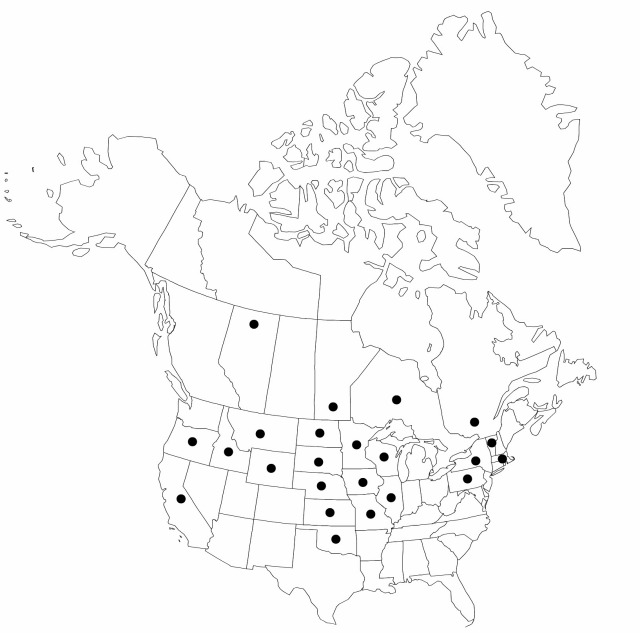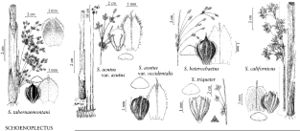Schoenoplectus heterochaetus
Cas. Nár. Mus., Odd. Prír. 140: 127. 1972.
Rhizomes 5–8 mm diam.; scales longer than internodes, disintegrating to fibers. Culms cylindric, 1.5–2.5 m × 4–8 mm. Leaves basal; sheaths often separating from culm, resembling blade, sometimes reddish proximally, front membranous-translucent, splitting, and delicately pinnate-fibrillose, orifice adaxially deeply V-shaped; ligules entire, 1 mm; blades 1–2, thinly C-shaped to thin and dorsiventrally flat in cross-section, much shorter to longer than sheath, distal blade to 220 × 5 mm. Inflorescences 2× branched, open, plano to concavo-convex, to 9 cm; proximal bract usually erect, thickly C-shaped to subterete in cross-section, 1–15 cm, margins often scabridulous. Spikelets 5–30, solitary or rarely 2 together, 5–15 × 3–4 mm; scales light orangebrown to nearly colorless, usually obscurely lineolate-spotted, midribs often greenish, ovateoblong, 3–4 × 1.5 mm, sparsely reddish or straw-colored-scabrous distally on awn, sometimes midrib, and rarely adjacent parts of sides, margins ciliate, hairs contorted, flanks veinless, apex obtuse, notch 0.5 mm deep, awn straight to slightly contorted, 0.3–1 mm. Flowers: perianth members 4 (–5), brown, bristlelike, equaling achene body or adaxial and abaxial much shorter, sparsely retrorsely spinulose; anthers 2 mm; styles 3-fid. Achenes dark graybrown, compressedtrigonous, obovoid, 2.2–3.2 × 1.4–1.9 mm; beak 0.3–1 mm. 2n = 38.
Phenology: Fruiting summer.
Habitat: Fresh, often calcareous marshes and lakes, often emergent in water to 1.5 m
Elevation: 10–500(–2000) m
Distribution

Alta., Man., Ont., Que., Calif., Idaho, Ill., Iowa, Kans., Mass., Mich., Minn., Mo., Mont., Nebr., N.Y., N.Dak., Okla., Oreg., Pa., S.Dak., Vt., Wis., Wyo.
Discussion
Schoenoplectus heterochaetus hybridizes with S. acutus and S. tabernaemontani (see comment under 1. S. tabernaemontani).
The Michigan record is dubious, the Oregon record is from 1895, and reports from Washington are apparently based on misidentified specimens. Some specimens from scattered localities in Eurasia may be Schoenoplectus heterochaetus.
Schoenoplectus lacustris (Linnaeus) Palla, of Eurasia, was collected near Camden, New Jersey, in 1889 and 1891; it now appears to be extirpated. It is also in cultivation in North America and should be sought. It is similar to S. heterochaetus, from which it differs in its often clustered spikelets, six long perianth bristles, and ability to form submerged ribbon-leaved forms, especially in flowing water in streams. 2n = 42.
Schoenoplectus lacustris hybridizes in Europe with S. tabernaemontani and S. triqueter.
Selected References
None.
Lower Taxa
"shortened" is not a number."thin" is not a number.
